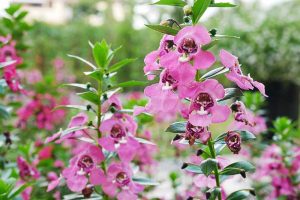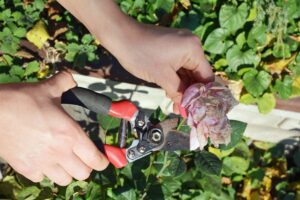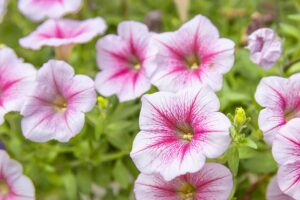Beautiful and familiar flowering vines, the Clematis genus is also a highly versatile and diverse group of plants.
They provide a wide range of sumptuous flower colors and blooms that range from small, nodding bells to extra-large starbursts.
The numerous species and hybrids offer an extended growing season, with varieties for spring, summer, and fall flowering times, and many that rebloom as well.
Growth habits are as varied as the many species, and range from sprawling, woody lianas to tidy, herbaceous ground covers.
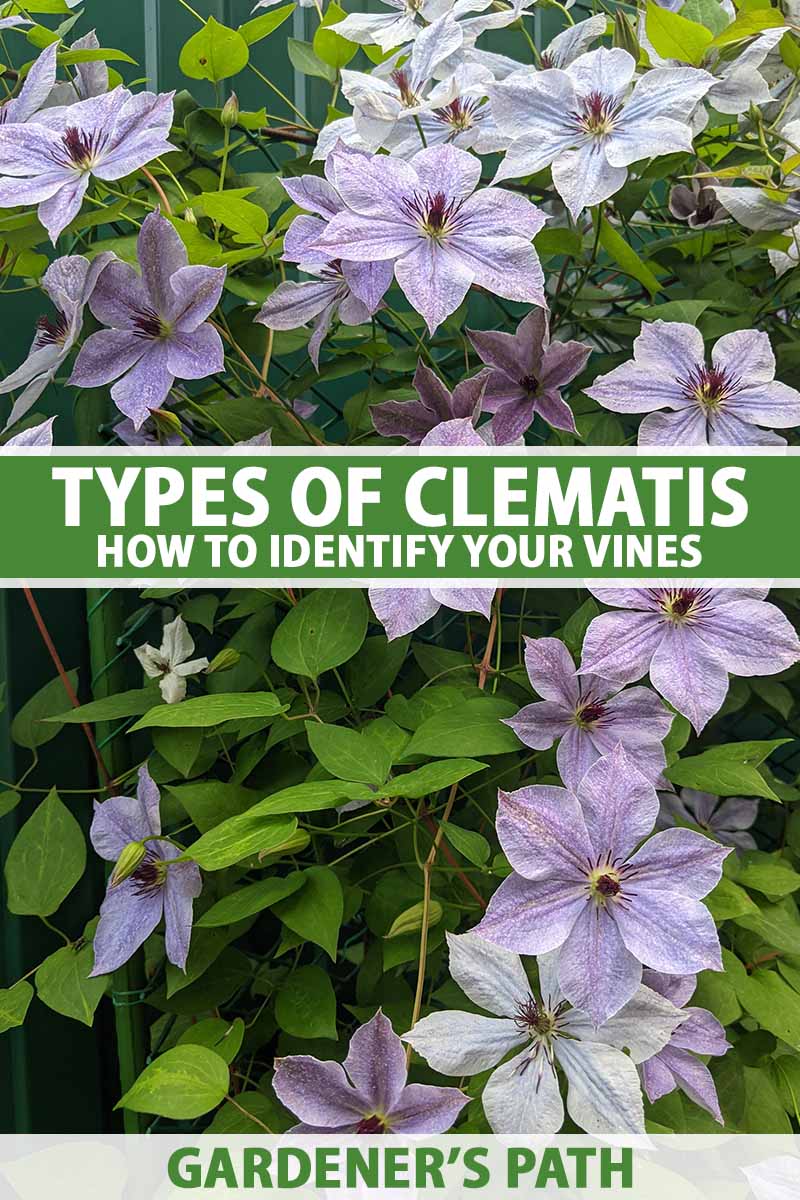
We link to vendors to help you find relevant products. If you buy from one of our links, we may earn a commission.
When given the right conditions, they can be prolific bloomers, covering fences, pergolas, and walls with weeks of dazzling floral displays. And giving them the right conditions is simple and easy.
Just keep the roots cool, allow the foliage to grow into the sun, and prune according to the needs of their cultivation group, and you’ll enjoy a bounty of blossoms.
But what if you inherited the vines and don’t know the name of your cultivar, or the group it belongs to? Read on – you can quickly learn about the types of clematis and how to identify your own vines right here!
Here’s a quick rundown of everything that’s ahead:
What Type of Clematis Do I Have?
Clematis is a large genus of perennials that includes about 300 species and numerous hybrids.
Garden varieties are mainly composed of robust climbing vines like C. jackmanii, but also include shrubby, upright types like C. recta, herbaceous species that die back in winter such as C. integrifolia, and non-clinging ground covers like C. jouiniana.

Most species are cold tolerant and deciduous in nature, losing their leaves in fall. But there are also those that remain evergreen in areas with mild winters, such as C. armandii.
Clematis varieties are divided into three groups according to their bloom times, growth characteristics, and pruning requirements.
Group 1 is the spring bloomers, Group 2 are repeat bloomers, and Group 3 are summer or fall bloomers.
Knowing your pruning group is important because different varieties flower at different times and at different growth sites – and incorrect pruning in can result in significant flower loss.
Some plants flower on old wood, some on new wood, and some develop buds on a combination of old and new growth.
Once you’ve identified your vines and know to which group they belong, a little annual pruning – or not – can transform them into fabulous, flowering showpieces. (There’s more on pruning techniques a little later, so keep reading.)
Several classification systems exist for clematis subdivisions. For the purpose of plant identification, the 12 groups outlined by Dr. John Howells, a founding member of the British Clematis Society, provides a good reference for the home gardener. We will outline these here.
When identifying a plant, it’s helpful to note the flower shape and size, flower orientation (downward-, outward-, or upward-facing), flowering season, and growth habits. Use this info to cross-reference your plants with the 12 groups to find a match.
For cultivation details, refer to our complete clematis growing guide.
Classification Groups
The 12 groups are listed in approximate order of flowering, with the appropriate pruning group noted for each one.
I. Evergreen
The first of the year to flower belongs to the Evergreen Group and includes popular species such as C. armandii and C. cirrhosa.
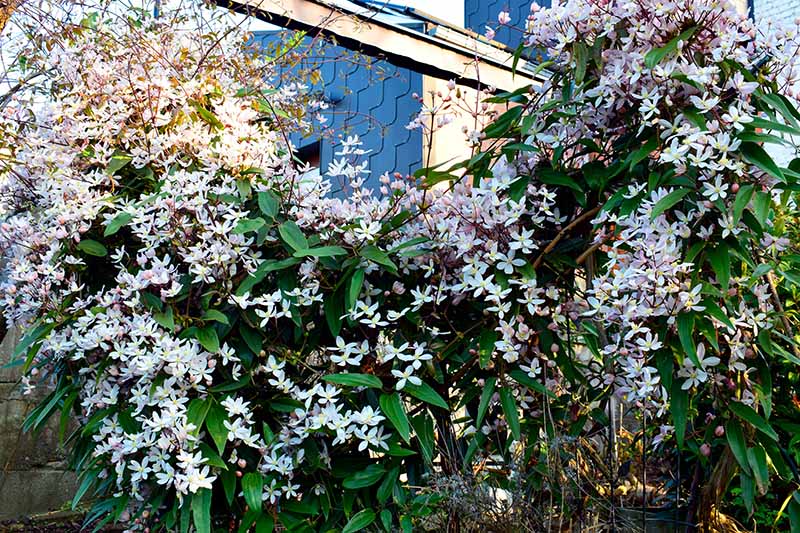
Suitable for areas with mild winters, the evergreens flower from December into April (depending on your region), offering a profusion of small, fragrant flowers. The open-faced, single flowers have four to eight petal-like sepals and measure one to four inches across.
Flowers in shades of white to creamy white or creamy pink, with a sweet, honey-almond scent, are delightful when most of the garden is still asleep.
The Evergreens form beautiful, year-round screens or dense canopies with thick, glossy, dark green leaves. After flowering, ornate silky seed heads adorn the vines.
Fast-growing to a length of 20 to 40 feet, these vines can develop thick stems, and with a dense canopy, they can become heavy – be sure to provide sturdy support for mature plants. ‘Apple Blossom,’ ‘Freckles,’ and ‘Wisely Cream’ are attractive evergreen examples.
C. armandii is hardy in USDA Zones 6 to 9, while C. cirrhosa is hardy in Zones 7 to 9. The Evergreens belong to Group 1, the spring bloomers, and require no annual pruning. A light grooming to clean and tidy vines is all that’s required.
II. Alpine
The Alpine Group, C. alpina, flower next in April and May, with single to double, nodding bells that open to reveal downward- or outward-facing, tutu-like flowers.
Petals range in number from four to 12 and flowers measure one to two inches in diameter in varying shades of blue, mauve, pink, and red.

Deciduous Alpines and their cultivars are vigorous climbers, growing six to 10 feet, and they prefer light shade, making them a good choice for east- or north-facing walls.
They’re also excellent as a ground cover or ramblers and develop showy, silvery seed heads after flowering.
Alpines are easy to train for growth on fences, trellises, or walls. ‘Jacqueline du Pre,’ ‘Pamela Jackman,’ and ‘Willy’ are popular cultivars.
Hardy in Zones 3 through 9, Alpines belong to Group 1 and require no annual pruning.
III. Macropetala
Members of the Macropetala Group, C. macropetala, are sometimes called downy clematis and flower in April and May, often reblooming lightly in summer.
The purply-blue, single or double flowers measure one to three inches across with four to 12 petals, and hang down like lanterns.
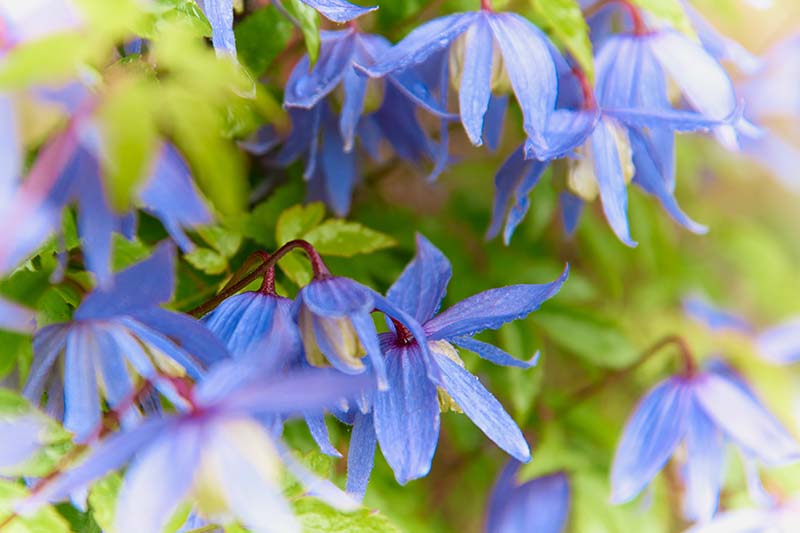
The vines make showy climbers or ground cover, growing eight to 12 feet in length and developing ornamental, silvery seed heads. ‘Blue Bird,’ ‘Jan Lindmark,’ and ‘Markham’s Pink’ are popular choices.
Hardy in Zones 4 to 9, Macropetalas belong to Group 1. No pruning is required, just lightly clean and tidy vines annually if needed.
IV. Montana
With massive waves of fragrant flowers from April into June, the Montana Group, C. montana, produces small, one- to two-inch single, semi, or double flowers with four to eight petals in multiple shades of pink to creamy white.
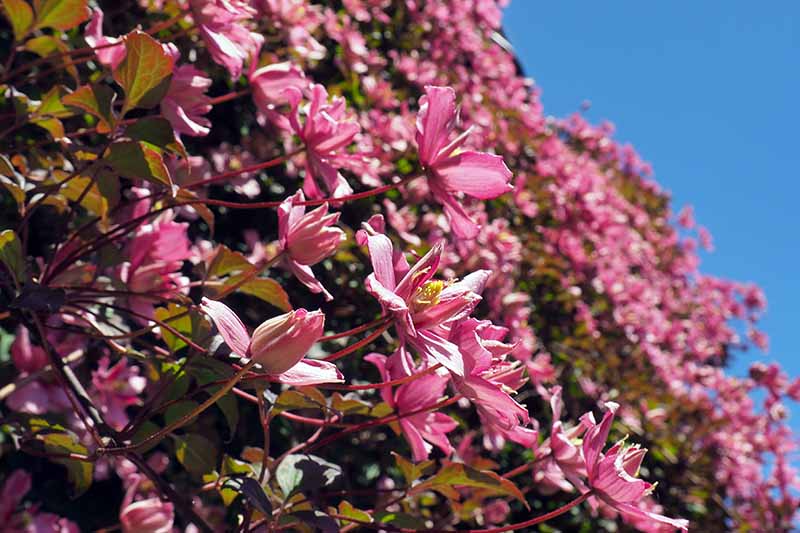
Fast-growing, strong, and extensive, Montana vines reach a mature height of 20 to 40 feet, displaying thousands of flowers when in bloom.
The deciduous foliage is often tinted reddish bronze and the plants in this group have good resistance to clematis wilt. ‘Freda,’ ‘Mayleen,’ and ‘Reuben’ are popular cultivars.
Hardy in Zones 6 to 9, Montanas are in Group 1 – no pruning needed outside of a light spring cleanup.
V. Rockery
The Rockery Group includes the evergreen species C. marmoraria and C. x cartmanii hybrids, low growing bush clematis plants that flower in April and May.
Like the Montanas, they produce masses of small, six-petaled, one- to two-inch flowers in tones of white to creamy white.
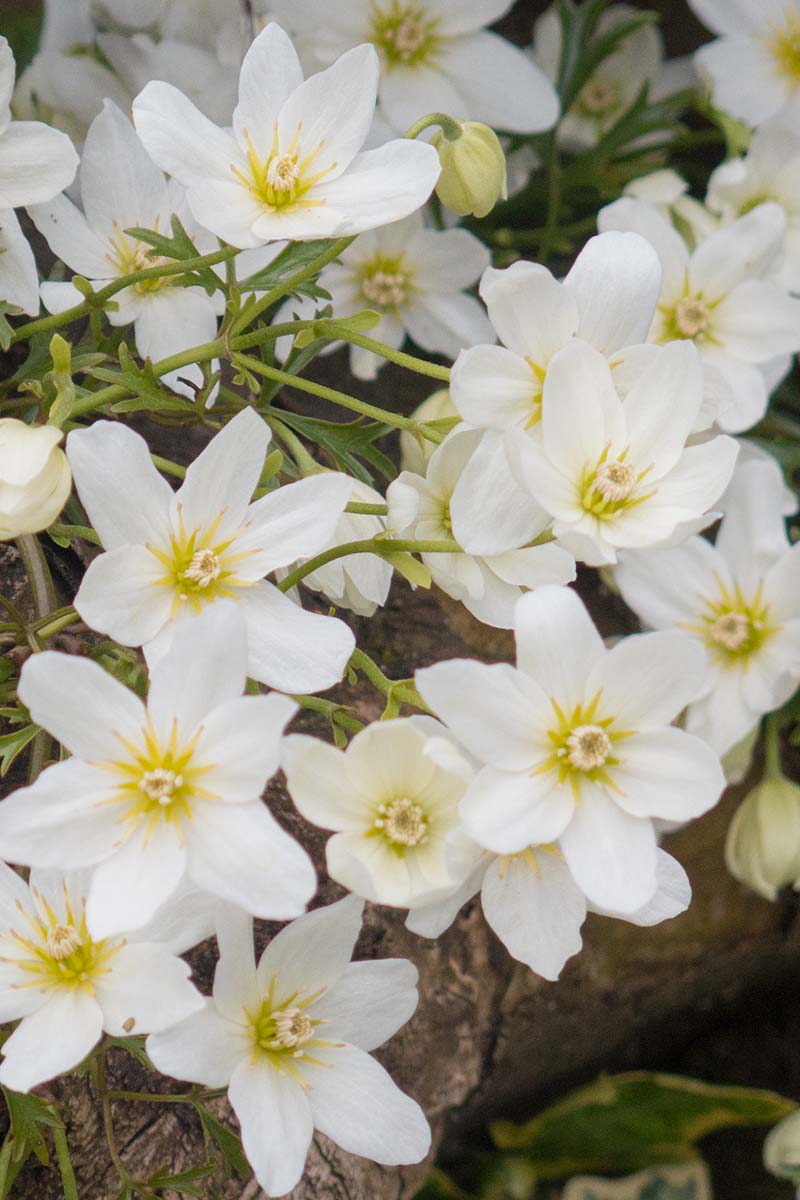
C. marmoraria is prostrate with parsley-like foliage and spreads up three feet, making it ideal for rockeries.
C. x cartmanii reaches a height of six feet and can be trained onto trellises, but it really shines when allowed to cascade, scramble, or tumble over retaining and rockery walls, from hanging baskets and window boxes, or as a ground cover.
‘Avalanche,’ ‘Joe,’ and ‘Pixie’ are popular cultivars. Hardy in Zones 7 to 9, the Rockery plants are in Group 1 and require no annual pruning.
VI. Early Large-Flowered
The Early Large-Flowered Group includes plants that bloom on short stems of old growth from the previous year, producing single to double, six- to 10-inch flowers in mid- to late spring.
After a brief rest, they typically repeat bloom on new growth in late summer and fall.

Members of this group produce large, luxurious, and open-faced flowers, and belong mainly to three Asian species: C. florida, C. lanuginosa, and C. patens.
Colors are lush and vibrant, and include shades of blue, burgundy, mauve, pink, purple, and white. Growth is typically four to 12 feet.
‘Duchess of Edinburgh,’ ‘General Sikorski,’ and ‘Nelly Moser’ are well-known cultivars. Hardy in Zones 4 to 11, they belong to Group 2, the repeat bloomers, and require pruning in early spring and again in early summer.
VII. Late Large-Flowered
The Late Large-Flowered group is abundantly floriferous, producing heavily on new growth only. The lush, showy flowers are single, semi-double, or double and measure five to eight inches, flowering from early summer into fall.
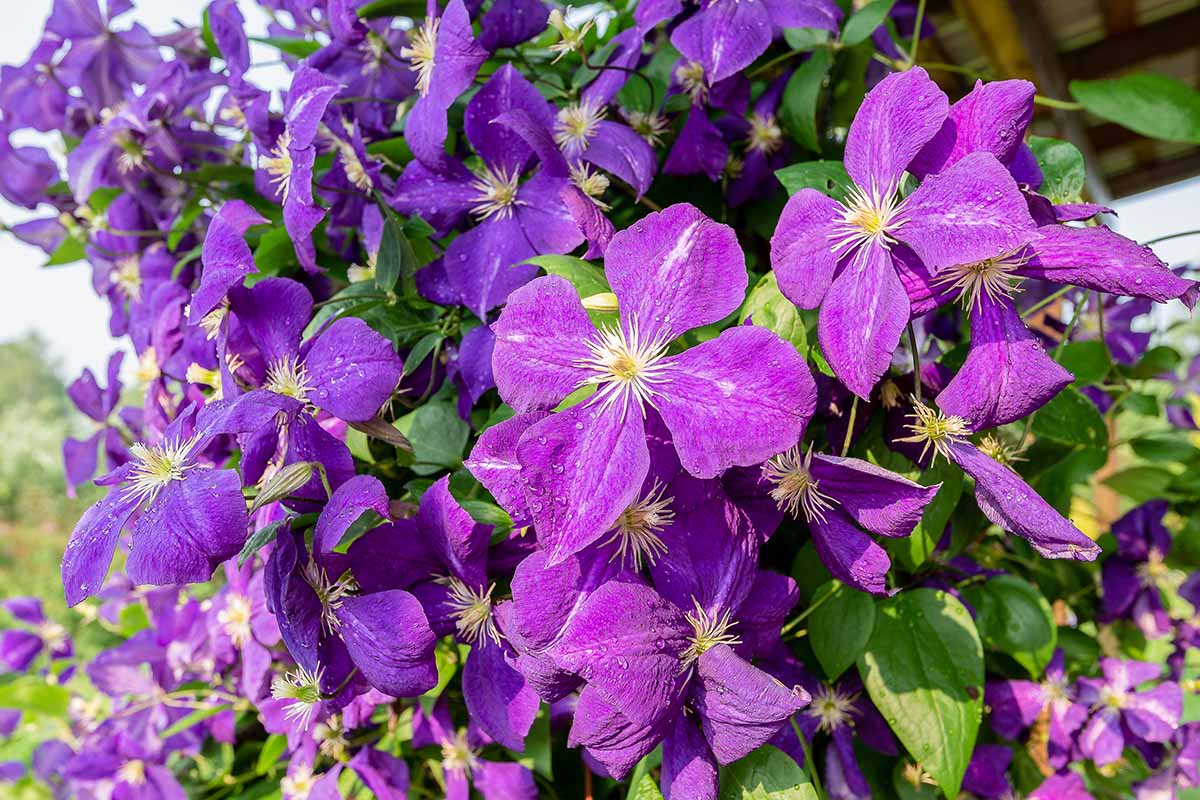
Cultivars and hybrids are mainly from the Asian species C. florida, C. lanuginosa, and C. patens, and the star-shaped flowers range in color from blue, burgundy, and mauve to pink, purple, red, and white.
Plants grow six to 12 feet, and popular cultivars include ‘Aotearoa,’ ‘Hagley Hybrid,’ ‘Jackmanii,’ and ‘Perle d’Azur.’
Hardy in Zones 4 to 11, the Late Large-Flowered types belong to Group 3, the summer or fall bloomers. A hard pruning is required in early spring.
VIII. Herbaceous
The Herbaceous Group includes a number of low-growing, non-twining plants that are excellent for clambering through borders and beds, or used as ground covers.
Nodding, two- to three-inch bell-shaped flowers often have twisted petals, and open out or upward in shades of blue, mauve, and pink.
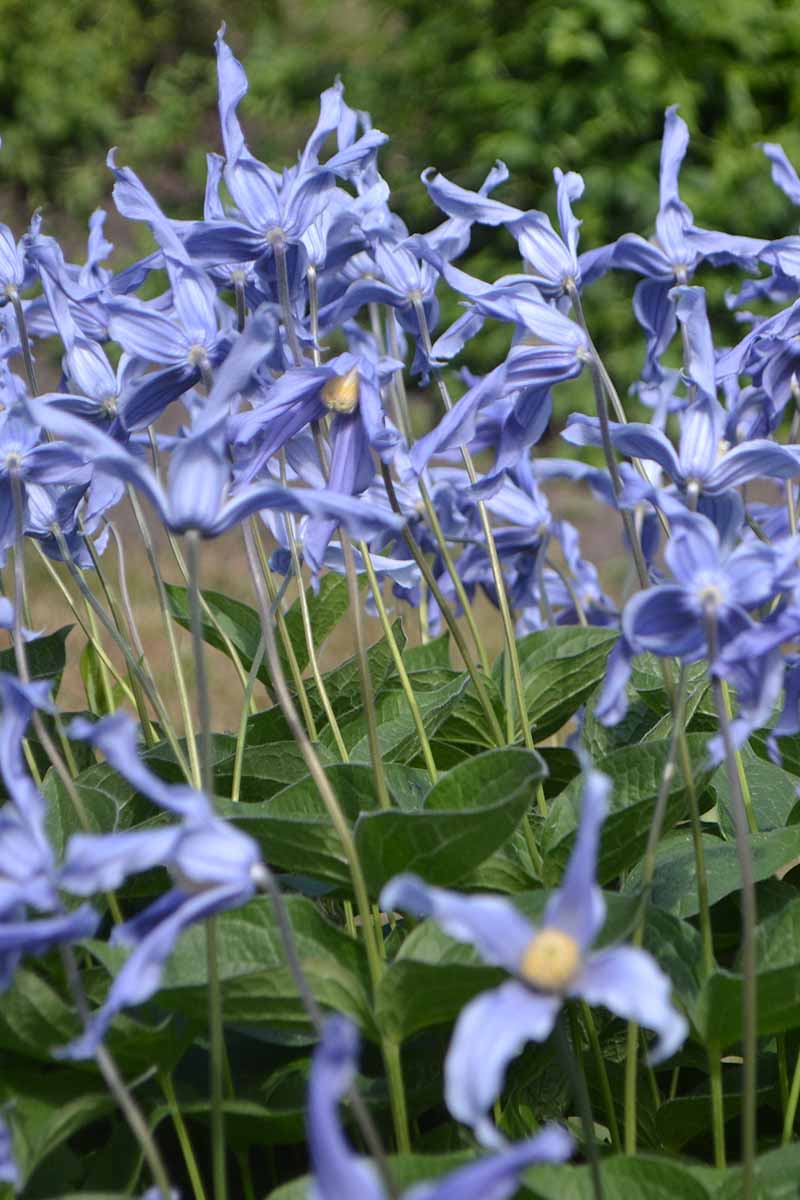
The main species in this group are C. heracleifolia, C. integrifolia, C. recta, C. stans and the hybrid C. x durandii. Flowers show from early summer into fall and develop pretty, silky seed heads after flowering.
The plants grow only 12 to 24 inches and spread three to 10 feet. Members of the Herbaceous Group die back in late autumn, losing their stems and foliage.
Well-known cultivars include ‘Arabella,’ ‘Juuli,’ and ‘Rosea.’ Hardy in Zones 4 to 11, herbaceous clematis belong to Group 3. Cut back plants in fall or simply allow them to die back on their own, and then rake up the debris.
IX. Viticella
Members of the Viticella Group, C. viticella, are loved for their robust growth, easy care, and beautiful, three- to five-inch open-faced flowers with broad, velvety petals that are often twisted or ruffled.

Free-flowering from early summer onwards, the blooms are single, semi-double, or double in shades of pale blue, magenta, mauve, pink, and purple.
Silky, platinum seed heads add interest after flowering, and vines reach a mature height of 10 to 15 feet.
‘Blue Angel,’ ‘Etoile Violette,’ and ‘Little Nell’ are well-known hybrid cultivars. Hardy in Zones 4 to 11, the Viticellas are in Group 3 and need a hard pruning in early spring.
X. Texensis
The Texensis Group includes hybrids and cultivars of C. texensis, the scarlet leather flower, and feature attractive, one- to three-inch tulip-shaped flowers with four to six lightly twisted petals in fiery shades of orange and red.
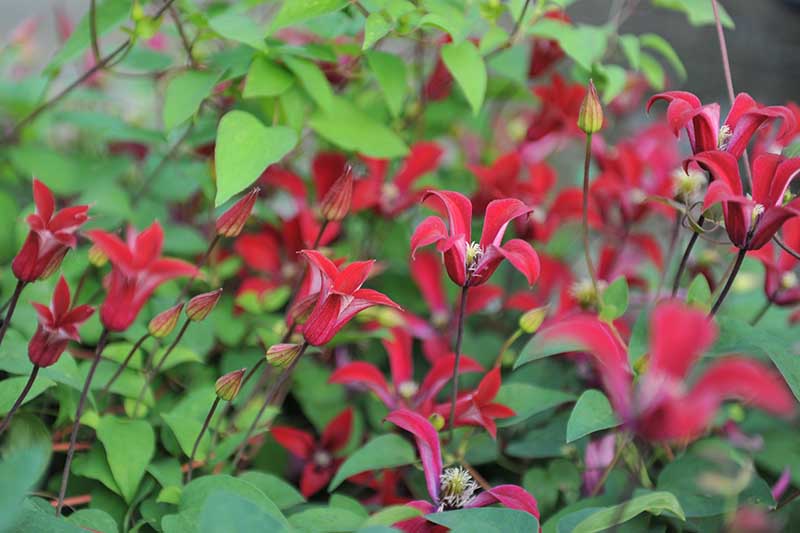
Flowering profusely from midsummer to frost, the vigorous vines give a showy display, clambering 10 to 15 feet with attractive blue-green foliage. Silky blond seed heads add fall appeal.
Examples of Texensis cultivars include ‘Gravetye Beauty,’ ‘Princess Diana,’ and ‘Sir Trevor Lawrence.’ Hardy in Zones 4 to 8, these plants are in Group 3 and should be cut back hard in early spring.
XI. Orientalis
The only group to offer a vivid, pure yellow, plants in the Orientalis give a profuse display of small, nodding flowers from midsummer into fall.
The flowers measure one to three inches across with four to eight petals and hang like bright, shining lanterns.
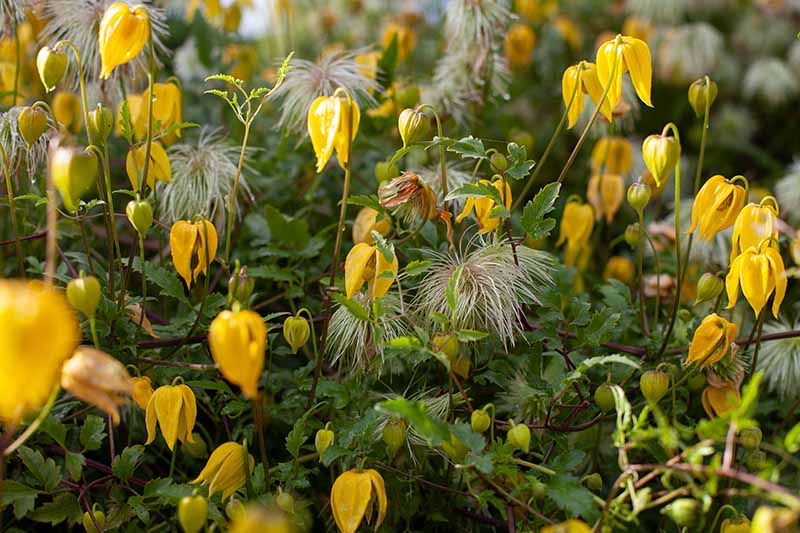
Also known as golden clematis, species include C. orientalis, C. serratifolia, C. tangutica, and C. tibetana.
Fast-growing and vigorous, the scrambling vines are easily trained and grow 15 to 20 feet. Pert, silky seed heads add interest throughout fall and winter.
‘Bill Mackenzie,’ ‘Golden Tiara,’ and ‘Kaska’ are good examples of the stunning features of the Orientalis Group. Hardy in Zones 4 to 11, they belong to Group 3 and should receive a hard pruning in early spring.
XII. Late Mixed Species
The Late Mixed Group contains the late-flowering, and often heavily scented, species such as C. flammula (aka fragrant virgin’s bower), C. mandshurica, C. potanini (old man’s beard), C. recta (ground virgin’s bower), and C. terniflora (sweet autumn clematis).

Vigorous climbers and scramblers, the robust vines flower from late summer into autumn, producing masses of small, one- to two-inch flowers in creamy white, mauve, and pure white followed by ornamental, silky seed heads.
Plants in this group grow between six and 30 feet, and most are hardy in Zones 5 to 9, with C. mandshurica being hardy down to Zone 3. All belong to Group 3 and require a hard pruning in late winter or early spring.
Pruning Tips for Each Cultivation Group
As mentioned previously, clematis fall into three groups based on their flowering time, growth habits, and pruning requirements – usually referred to as Groups 1, 2, and 3 and sometimes as Groups A, B, and C.
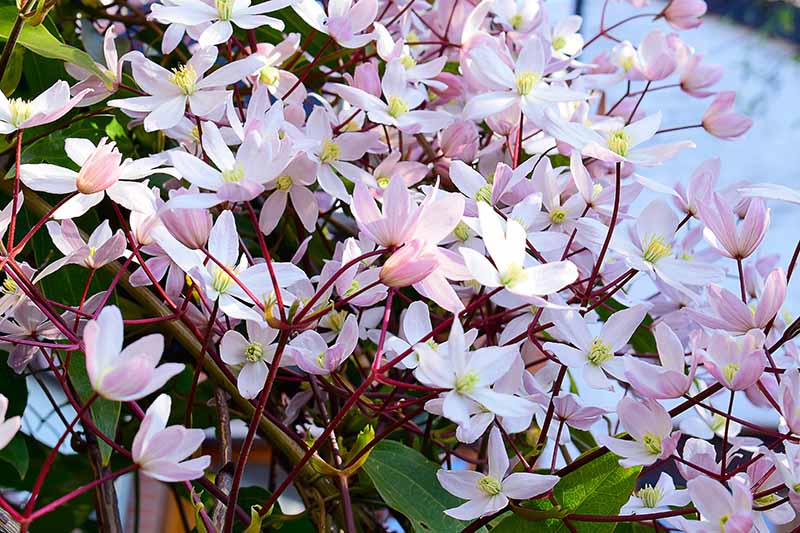
Here’s how to prune for each group.
Group 1
Group 1 are the early-season bloomers, flowering in late winter and early to mid-spring.
Plants in this group flower on shoots that emerge from old wood, and don’t require any pruning. The stems can become thick and woody, and an annual light grooming or cleanup is all they need.
To groom vines, do so immediately after flowering. Trim lightly to thin out tangled growth, remove dead wood, or to reshape and resize.
See a list of our favourite group 1 cultivars here.
Group 2
Group 2 includes the early, large-flowered cultivars that bloom in late spring and early summer, with many producing a second, lighter flush of flowers in late summer to autumn.
The first wave of flowers form on new shoots from old wood, or last year’s growth. And the second wave is produced on new growth in the current growing season.
These vines require a moderate amount of selective pruning twice in one growing season.
Prune first in early spring, just as new buds emerge.
To do so, remove any dead or damaged stems. At the same time, lightly cut back up to one-third of the remaining stems to a pair of robust buds at about 12 inches from the ground.
Heavy pruning or size reduction should be avoided at this time, because it will significantly reduce the volume of flowers – keep in mind that first-wave flowers form on old wood.
To encourage a second wave, prune for a second time immediately after the first wave of blossoms finishes.
After flowering, or in early summer, deadhead thoroughly, or cut back stems to a healthy side shoot or strong set of buds.
Early summer is also the time to reshape or reduce vine size. But do so with a light touch – old wood is still needed for producing next year’s flowers.
To retain as many blossoms as possible, reshape gradually by cutting back the vines by one-quarter to one-third over the course of a few years.
See a list of our favourite group 2 cultivars here.
Group 3
Group 3 members are the late-blooming varieties that flower from midsummer through autumn, forming flowers entirely on new wood from the current year.
The late bloomers require a single, hard pruning in late winter to early spring, or once the leaf buds are swollen and emerging.
Prune them hard by snipping back all of the stems to around 12 inches, cutting each stem just above a set of strong, healthy buds.
Clean and remove old stems and debris from around the base of the vines, and from any supporting structures.
See a list of our favourite group 3 cultivars here.
Read our full guide to pruning clematis here.
Beautiful Blooming Vines
Healthy, well-maintained clematis make a striking, long-term addition to the garden, providing weeks of colorful flowers, attractive seed heads, and sometimes a sweet perfume.
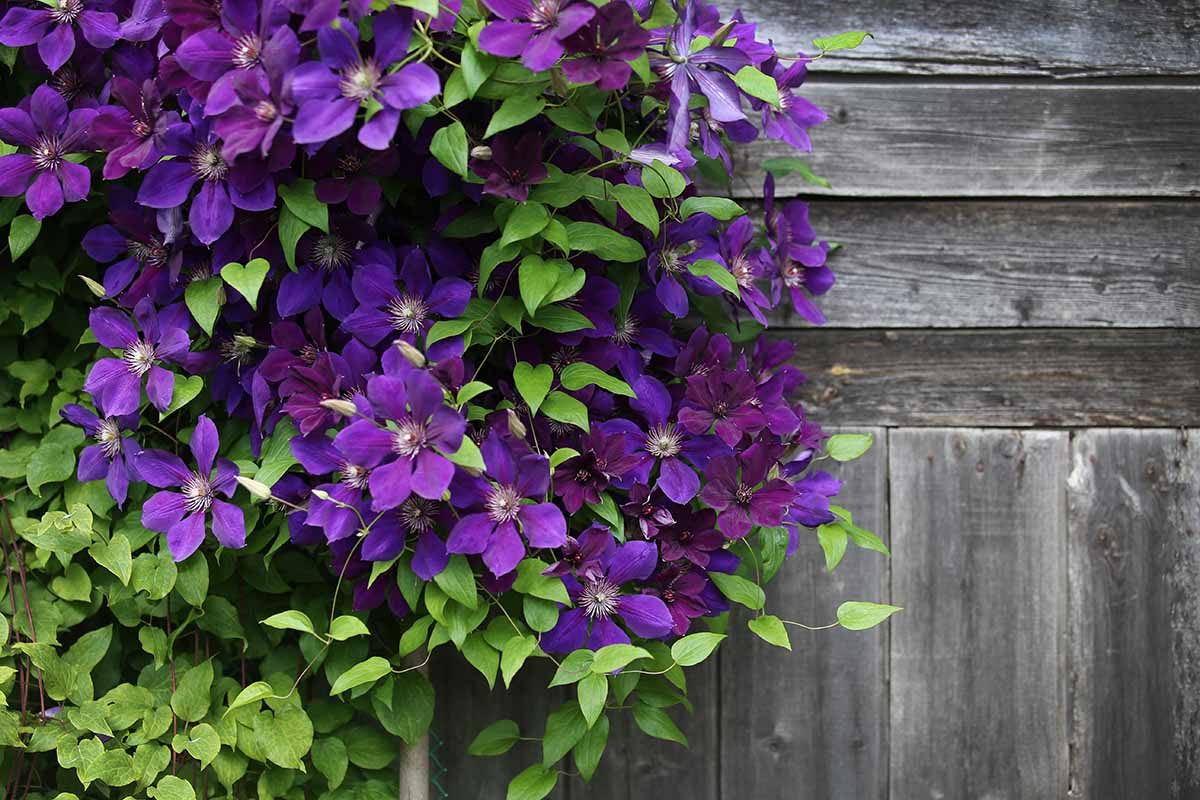
Use the descriptions outlined here to find a match for your mystery plants, comparing blooming season, flower colors and sizes, flower orientation, growth habits, and vine sizes.
Once you know the type of clematis you’re growing, simply give them the care and pruning needed for the growth and pruning groups they belong to – then enjoy beautiful, blooming vines for years to come!
Did you identify a mystery plant in your yard? What type are you growing? Share your stories and photos in the comments section below, and we’re happy to address any questions you may have as well.
For more clematis suggestions and tips, check out these guides next:
